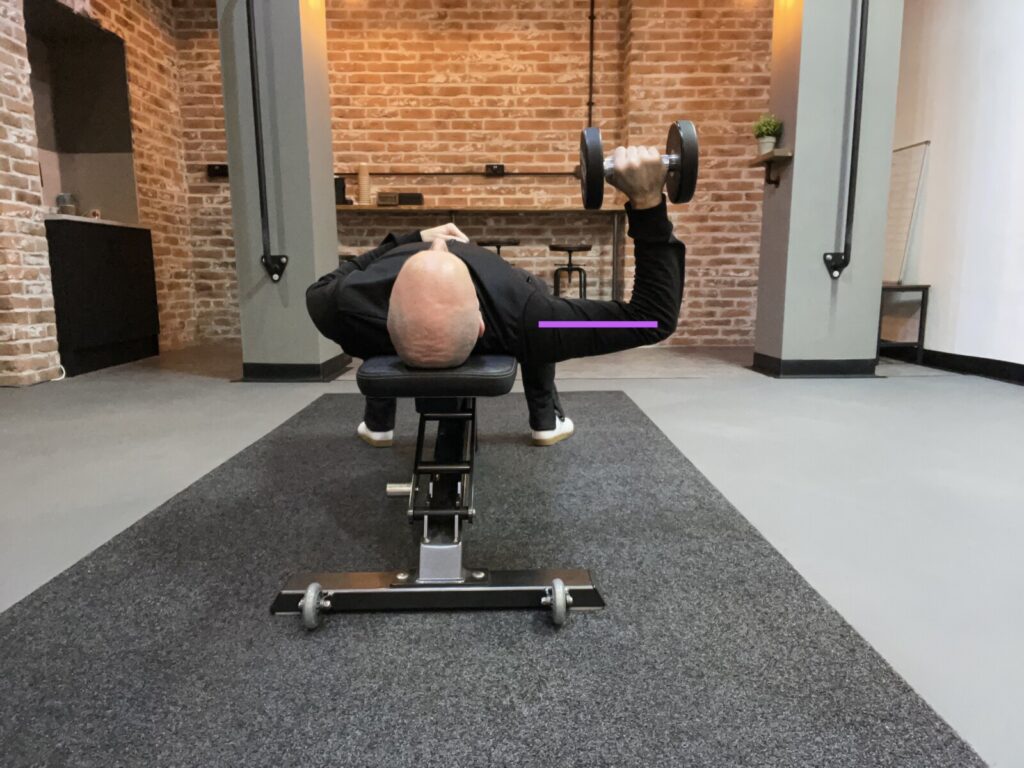In this post we discuss 5 things you can try if an exercise causes you pain.

You’re training in the gym and an exercise that’s never caused you issues before suddenly causes you discomfort.
What can you do?
First of all don’t push through the pain.
Unless you’ve taken very specific advice from a specialist, it’s not advisable to exercise through pain. This is usually counterproductive.
You don’t need to take a week off either though. Rest probably won’t help and isn’t necessary unless the pain is severe.
You’ll obviously need to exercise a little common sense here. For the purpose of this post I’ll presume we’re talking about a mild pain which occurred whilst resistance training.
OK so what are your options if you experience pain during a particular exercise in the gym?
1) Lower the weight and / or reduce the moment arm (MA)
None of us like to feel like we’re going backwards, but reducing the amount of force you’re working with doesn’t necessarily indicate this.
Each workout should be seen as both part of an overall plan and also discrete.
The conditions that lead up to a training session are never the same. Lack of sleep, stress and eating poorly can all lead to temporary declines in performance. That’s OK.
To reduce the challenge of a particular exercise you can simply select a lighter weight, or reduce the size of the moment arm (MA) you’re working with.
The MA is defined as the shortest distance between the line of force and the joint the weight is trying to move.
In a chest fly for example, simply bending your elbow will reduce the MA to your shoulder and therefore reduce the forces that are acting on it.


You could reduce the forces further by choosing to perform the same exercise on a 4:1 cable machine.
Be flexible and train the body you have on that particular day. Not the one your programme says you have.
If altering the forces you’re working against helps, that’s a win.
2) Reduce the range of motion you’re working through
If you only get pain when you approach one particular part of the motion, then avoid this for the moment. Say you reduce the sweep of the repetition by 10%, you still have 90% to train in without causing yourself issues.
Enjoy that for the moment and see what happens.
3) Use isometrics in pain free parts of the range
If I had to choose one particular type of muscle contraction that seems to have a disproportionate impact on pain it would be isometrics.
Isometrics are muscle contractions without movement of the joints those muscles act upon. You might also see them described as static contractions.
You can use them to challenge muscles in pain free portions of the exercise that’s causing you problems. Or even experiment with them in more provocative parts of the range.
As long as you use low intensity contractions to begin with, you won’t cause yourself further problems and may experience a benefit.
4) Change the orientation of your body
Let’s say you experience back pain whist using the hip abduction machine. This is the exercise where you push your legs out to the side against a resistance.
Better machines will give you the option of either declining or inclining the seat. Experimenting with this setting alone may reduce sensations in your back.
If you don’t have that option try performing the same movement in standing, lying on your side, or even lying on your front.
These variations will not only alter the forces acting on your hip joint, but also those acting on your back.
A movement that is painful in one position, can become completely pain free in another.
5) Change the position of the joints above or below the one you’re challenging
For example, it’s not uncommon to experience back pain whilst using the leg extension machine. This can be provoked by tension at the back of your legs as you straighten your knees.
Altering the position of either your ankles or your hips can have a dramatic impact on this sensation.
Pointing your ankles away from you during the exercise will help reduce tension in the nerves at the back of your legs.
Whilst sliding the seat further back and using a pad to support your back will reduce the amount of hip flexion you’re in and help those hamstrings relax a little.
Summary
When we experience pain or discomfort during an exercise we are sometimes tempted to either push through it, or avoid the exercise all together.
Taking a bit of time to experiment with some of the variables in the exercise can both help alleviate unpleasant sensations and help us learn more about our bodies.